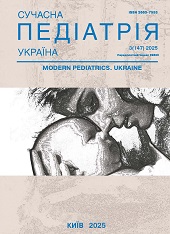Endothelial dysfunction in children with SARS-CoV-2-associated pneumonia and its dependence on the activity of the infectious-inflammatory process
DOI:
https://doi.org/10.15574/SP.2025.3(147).2934Keywords:
endothelial dysfunction, SARS-CoV-2, pneumonia, children, endothelin-1, VEGF, C-reactive proteinAbstract
One of the key pathogenetic mechanisms of COVID-19 is endothelial dysfunction, which enhances prothrombotic phenomena, endotheliitis, and multiorgan immunothrombosis. The mechanisms of endothelial damage in children remain insufficiently studied.
Aim: to determine the levels of endothelial dysfunction in children with SARS-CoV-2-associated pneumonia and to analyze its relationships with clinical and laboratory indicators of the activity of the infectious and inflammatory process.
Materials and methods. The Main group consisted of 160 children with SARS-CoV-2-associated pneumonia and 40 healthy children (Control group). The Main group was divided depending on gender, age, disease severity, levels of C-reactive protein (CRP), and procalcitonin. To assess endothelial dysfunction, the level of endothelin-1 and vascular endothelial growth factor (VEGF) in blood serum was determined.
Results. The values of VEGF and endothelin-1 were the highest in patients with severe pneumonia. The values of laboratory markers of endothelial dysfunction were significantly higher with higher levels of CRP in children of the Main group by 31.95% and 33.14% for endothelin-1 and VEGF, respectively. A positive medium-strength relationship was established between the values of fibrinogen and CRP with VEGF levels; a weak positive relationship between the levels of VEGF and procalcitonin; fibrinogen and endothelin-1 levels. A probable medium-strength positive relationship was established between the values of endothelin-1 and VEGF, with the levels of interleukins (IL) 1, 6.
Conclusions Children of the Main group have endothelial dysfunction, as evidenced by increased levels of endothelin-1 and VEGF. These values were associated with disease severity, CRP levels, and gender. VEGF levels were highest in patients with severe pneumonia. There was a moderate positive association between laboratory markers of endothelial dysfunction, such as endothelin-1
References
Garg S, Kim L, Whitaker M, O'Halloran A, Cummings C, Holstein R et al. (2020, Apr 17). Hospitalization Rates and Characteristics of Patients Hospitalized with Laboratory-Confirmed Coronavirus Disease 2019 - COVID-NET, 14 States, March 1-30, 2020. MMWR Morb Mortal Wkly Rep.;69(15):458-464. https://doi.org/10.15585/mmwr.mm6915e3; PMid:32298251 PMCid:PMC7755063
Hoang A, Chorath K, Moreira A et al. (2020). COVID-19 in 7780 pediatric patients: A systematic review. E. Clinical Medicine. 24: 100433. https://doi.org/10.1016/j.eclinm.2020.100433; PMid:32766542 PMCid:PMC7318942
Iba T, Levy JH, Levi M, Thachil J. (2020) Coagulopathy in COVID‐19. J. Thromb. Haemost. 18(9): 2103-2109. https://doi.org/10.1111/jth.14975; PMid:32558075 PMCid:PMC7323352
Kovalenko SV. (2020). Experience with the use of syndrome-pathogenetic therapy methods for pneumonia caused by COVID-19 in a pulmonology department. Medical Newspaper "Health of Ukraine in the 21st Century". 13-14: 481-482.
Lu X, Zhang L, Du H, Zhang J, Li YY, Qu J et al. (2020, Apr). 23SARS-CoV-2 Infection in Children. N Engl J Med. 382(17): 1663-1665. Epub 2020 Mar 18. https://doi.org/10.1056/NEJMc2005073; PMid:32187458 PMCid:PMC7121177
Varga Z, Flammer A, Steiger P et al. (2020). Endothelial cell infection and endotheliitis in COVID-19. The Lancet. 395(2): 1417-1418. https://doi.org/10.1016/S0140-6736(20)30937-5; PMid:32325026
Viner RM, Mytton OT, Bonell C, Melendez-Torres GJ, Ward J, Hudson L et al. (2021, Feb 1). Susceptibility to SARS-CoV-2 Infection Among Children and Adolescents Compared With Adults: A Systematic Review and Meta-analysis. JAMA Pediatr. 175(2): 143-156. doi: 10.1001/jamapediatrics.2020.4573. Erratum in: JAMA Pediatr. 2021 Feb 1;175(2):212. https://doi.org/10.1001/jamapediatrics.2020.4907; PMCid:PMC7607487
Wright FL, Vogler TO, Moore EE et al. (2020). Fibrinolysis shutdowncorrelates to thromboembolic events in severe COVID-19 infection. J Am Coll Surg. 231(2): 193-203.e1. Epub 2020 May 15. https://doi.org/10.1016/j.jamcollsurg.2020.05.007; PMid:32422349 PMCid:PMC7227511
Downloads
Published
Issue
Section
License
Copyright (c) 2025 Modern pediatrics. Ukraine

This work is licensed under a Creative Commons Attribution-NonCommercial 4.0 International License.
The policy of the Journal “MODERN PEDIATRICS. UKRAINE” is compatible with the vast majority of funders' of open access and self-archiving policies. The journal provides immediate open access route being convinced that everyone – not only scientists - can benefit from research results, and publishes articles exclusively under open access distribution, with a Creative Commons Attribution-Noncommercial 4.0 international license (СС BY-NC).
Authors transfer the copyright to the Journal “MODERN PEDIATRICS. UKRAINE” when the manuscript is accepted for publication. Authors declare that this manuscript has not been published nor is under simultaneous consideration for publication elsewhere. After publication, the articles become freely available on-line to the public.
Readers have the right to use, distribute, and reproduce articles in any medium, provided the articles and the journal are properly cited.
The use of published materials for commercial purposes is strongly prohibited.

